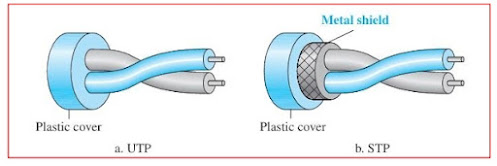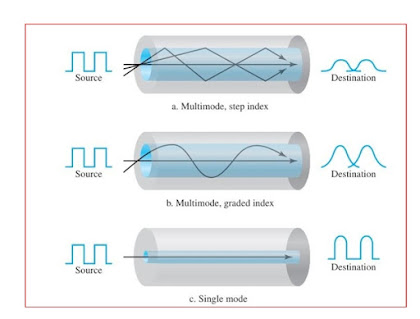Transmission Media in Computer Network ,Categories of Transmission Media, Guided Media in Transmission Media, Types of Propagation Modes, Advantages of Fiber Optic Cables, Advantages of Coaxial Cables,
PART 1 :
TRANSMISSION MEDIA :
Transmission media are essentially the physical substances through which information travels.
They operate at a level below the physical layer of the OSI model, often referred to as "layer zero."
Essentially, transmission media can be considered as a fundamental layer that directly interfaces
with the physical layer.
Data Communications Examples:
- Transmission media include free space, metallic cables, or fiber-optic cables.
- The information transmitted is usually in the form of signals generated from data.
- Telegraph (19th Century): Invented by Morse, it was an early long-distance communication technology using metallic wires, but was slow.
- Telephone (1869): Allowed voice transmission over long distances via metallic cables, though communication quality was poor due to inferior wires.
- Wireless Communication (1895): Hertz transmitted high-frequency signals, and Marconi later improved this by sending messages across the Atlantic Ocean.
- Improved Metallic Media: Development of twisted-pair and coaxial cables has enhanced data transmission.
- Optical Fibers: The advent of fiber-optic cables has significantly increased data transmission rates.
- Efficient Use of Free Space: Advances in modulation and multiplexing have optimized the use of free space (air, vacuum, water) for communication.
Electromagnetic Spectrum:
- Signals and Electromagnetic Energy: Computers and telecommunication devices transmit data as electromagnetic energy, which includes power, radio waves, infrared, visible light, ultraviolet light, and X-rays.
- Spectrum Usability: Not all parts of the electromagnetic spectrum are suitable for telecommunications. Only certain portions are used, and the types of media to harness these are limited.
Categories of Transmission Media:
1. Guided Media: These include twisted-pair cables, coaxial cables, and fiber-optic cables.
2. Unguided Media: This refers to free space, such as air and vacuum.
Guided Media :
Guided media are types of communication channels that provide a specific path for signals to travel
from one device to another. These include:
1. Twisted-Pair Cable: This type of cable consists of pairs of insulated copper wires twisted
together. The twisting helps reduce electromagnetic interference and maintains signal
quality.
2. Coaxial Cable: Coaxial cables have a central conductor, an insulating layer, a metallic
shield, and an outer insulating layer. This structure helps to protect the signal from
interference and allows for high-speed data transmission.
3. Fiber-Optic Cable: Unlike twisted-pair and coaxial cables, fiber-optic cables use light
signals to transmit data. They consist of thin strands of glass or plastic that carry light pulses
over long distances with minimal signal loss.
Noise and Interference :
Twisted pair cables are designed to minimize the impact of interference (noise) and crosstalk.
When the wires are parallel, noise or crosstalk can affect each wire differently due to their varying
distances from the sources of interference. By twisting the wires, the cable maintains a balance. In
each twist, the relative positions of the wires to the noise source change, helping to ensure that
both wires experience similar levels of interference. This twisting reduces the impact of unwanted
signals, as the receiver calculates the difference between the wires, canceling out most of the noise.
Shielded vs. Unshielded Twisted-Pair Cables :
Unshielded Twisted-Pair (UTP): The most common type used in communications, UTP
cables do not have additional shielding. They are less expensive and less bulky but can be
more susceptible to interference.
Shielded Twisted-Pair (STP): STP cables have an additional metal foil or braided mesh
covering each pair of conductors. This shielding reduces interference and improves signal quality but makes the cables bulkier and more costly. STP is primarily used by IBM and is
less common outside of their applications.
Categories of UTP Cables :
The Electronic Industries Association (EIA) classifies UTP cables into seven categories, with
Category 1 being the lowest quality and Category 7 being the highest. Each category is suitable
for specific applications, and the standards help ensure the cable meets certain performance
criteria.
Connectors :
The RJ45 connector is the most common connector for UTP cables. It is a keyed connector,
meaning it can only be inserted in one direction, which ensures a proper connection.
Performance :
The performance of twisted-pair cables is often assessed by measuring attenuation (signal loss) in
relation to frequency and distance. Although twisted-pair cables can handle a broad range of
frequencies, attenuation increases significantly at frequencies above 100 kHz. Attenuation is
measured in decibels per kilometer (dB/km), and higher frequencies result in greater signal loss.
Applications :
Twisted-pair cables are widely used in various applications:
1. Telephone Lines: Used for voice and data transmission in the local loop connecting
subscribers to telephone offices.
2. DSL Lines: Provide high-data-rate connections by utilizing the high bandwidth of UTP
cables.
3. Local-Area Networks (LANs): Employed in networks such as 10Base-T and 100Base-T
for data transmission.
Coaxial Cable :
Coaxial cable, often referred to as coax, is designed to carry high-frequency signals, unlike twisted-
pair cables. It consists of the following parts:
Central Core Conductor: A solid or stranded copper wire, responsible for carrying the
signal.
Insulating Sheath: Surrounds the core conductor, separating it from the outer conductor.
Outer Conductor: Made of metal foil, braid, or both, which serves two purposes:
- Acts as a shield against external noise.
- Functions as the second conductor to complete the circuit.
Additional Insulation: Encases the outer conductor for further protection.
Plastic Cover: Provides external protection for the entire cable.
Coaxial Cable Standards (RG Ratings) :
Coaxial cables are classified based on Radio Government (RG) ratings. Each RG number specifies
certain physical characteristics of the cable, such as:
- Wire Gauge: Thickness of the inner conductor.
- Insulation: Thickness and material of the inner insulator.
- Shielding: Design and construction of the outer conductor.
- Outer Casing: Size and type of the protective cover.
These RG-rated cables are suited for different specialized applications, as indicated by their
specifications.
 |
| TABLE RG-rated cables are suited for different specialized applications. |
- Coaxial Cable Connectors To connect coaxial cables to devices, special connectors are required. The most common connector type is the Bayonet Neill-Concelman (BNC) connector.
There are different variations of this
connector:
BNC Connector: Used to connect the cable to a device (e.g., a TV).
BNC T Connector: Often used in Ethernet networks to split the signal to multiple devices.
BNC Terminator: Placed at the end of the cable to prevent signal reflection and ensure
stable transmission.
 |
| Fig.. BNC connectors |
Performance of Coaxial Cables :
Coaxial cables provide higher bandwidth compared to twisted-pair cables, allowing them to carry
more data. However, their attenuation (signal weakening) is greater, meaning the signal degrades
over distance and requires frequent use of repeaters to maintain signal strength
Applications :
- Analog Telephone Networks: Coaxial cables were used to carry large amounts of voice signals, with one cable supporting up to 10,000 voice channels.
- Digital Telephone Networks: Coaxial cables were capable of transmitting digital data at speeds up to 600 Mbps.
Today, fiber optic cables have largely replaced coaxial cables in telephone networks due to their
superior performance.
Fiber-Optic Cable :
A fiber-optic cable is a medium made of glass or plastic that transmits signals as light. To
understand how it works, it's important to first grasp the nature of light.
Properties of Light :
 |
| Fig. Bending of light ray |
- Light travels in a straight line when moving through a uniform material.
- If light passes from one substance into another with a different density, the direction changes (refraction).
- Critical Angle: The angle of incidence at which light bends along the boundary between two materials. If the angle is greater than the critical angle, the light reflects instead of refracting.
Structure of Optical Fibers :
Optical fibers guide light through internal reflection. The core (made of glass or plastic) is
surrounded by a cladding with lower density. This ensures that light reflecting off the core-
cladding boundary remains in the core.
Propagation Modes :
Optical fibers use two main modes for light propagation:
- Step-Index Fiber: The core has uniform density, and light changes direction abruptly at the core-cladding interface.
- Graded-Index Fiber: The core's density gradually decreases from the center, reducing signal distortion.
Single-Mode: Uses step-index fiber but has a smaller core and tightly focused light. The
beams travel nearly parallel, minimizing delay and distortion.
Fiber Sizes :
Optical fibers are classified by the ratio of core diameter to cladding diameter (both measured in
micrometers). Single-mode fibers typically have a smaller core diameter compared to multimode
fibers.
Fiber-Optic Cable Composition :
A typical fiber-optic cable consists of:
- Outer jacket (PVC or Teflon)
- Kevlar strands for strength
- Plastic coating for cushioning
- Core and cladding for light transmission.
Fiber-Optic Connectors :
There are three types of connectors:
- SC (Subscriber Channel): Push/pull locking, used in cable TV.
- ST (Straight Tip): Bayonet locking, used in networking.
- MT-RJ: Same size as RJ45, used for data networks.
Performance :
Fiber-optic cables experience less signal attenuation than twisted-pair or coaxial cables, requiring
fewer repeaters. They also support higher data transfer rates, especially with wavelength-division
multiplexing (WDM).
Applications :
- Backbone Networks: Due to their wide bandwidth, fiber-optic cables are used in backbone networks, such as SONET.
- Hybrid Networks: Some cable TV companies use a mix of fiber-optic and coaxial cables.
- Local Area Networks (LANs): Fiber-optic cables are used in networks like 100Base-FX and 1000Base-X.
Advantages of Optical Fiber :
- Higher Bandwidth: Supports higher data rates.
- Less Signal Attenuation: Can transmit over longer distances without needing repeaters.
- Immunity to Electromagnetic Interference: Not affected by electromagnetic noise.
- Resistance to Corrosive Materials: More durable in harsh environments.
- Lightweight: Lighter than copper cables.
- Greater Immunity to Tapping: More secure than copper cables.
Disadvantages of Optical Fiber :
- Installation and Maintenance: Requires specialized skills.
- Unidirectional Light Propagation: Requires two fibers for bidirectional communication.
- Cost: More expensive than other cables, especially if bandwidth demand is low.
Fiber-optic cables offer numerous benefits, particularly in high-bandwidth and long-distance
applications, but their costs and technical requirements must be carefully considered.
Tags:
Computer network












